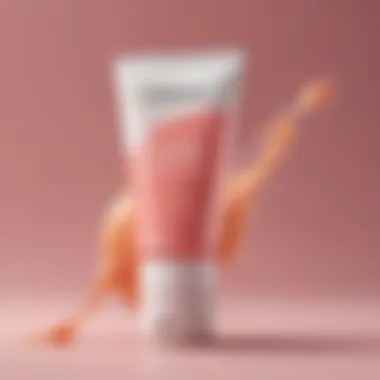Comprehensive Guide to Hair Removal Creams for Bikini Area


Intro
In the ever-evolving world of beauty and personal grooming, hair removal creams have carved out a specialized niche, especially for the bikini area. This area is often sensitive and can be tricky to manage. The convenience and effectiveness of hair removal creams make them a popular choice. Yet, many users have questions. What ingredients should you look for? How should you apply them? What safety considerations are essential? This article aims to answer these questions and provide insights that beauty enthusiasts crave.
From ingredient breakdowns to practical application methods, each section will unfold critical details and thoughtful analysis. The objective is to ensure that readers can make informed decisions using hair removal creams for their bikini area. Understanding the potential benefits and drawbacks can lead to more satisfying results in personal grooming routines.
As we proceed, we will dissect various topics. We will navigate through the formulation of these creams, discuss alternatives, and highlight important safety tips. This guide promises to be a comprehensive resource for anyone seeking reliable information on hair removal options.
As you delve deeper, you will discover not only the functionality of these products but also how they fit into the broader landscape of beauty trends and personal style. We acknowledge that everyone may have different needs. Therefore, personalized insights will be emphasized where relevant.
For now, let’s begin by highlighting some relevant fashion trends surrounding bikini grooming.
Prologue to Hair Removal Creams
When discussing grooming choices, hair removal creams have become a staple for many individuals, especially for sensitive areas such as the bikini line. Their convenience and effectiveness offer a range of benefits that appeal particularly to those who prioritize both efficiency and comfort in personal care routines. This section aims to outline the fundamentals of hair removal creams, highlighting their relevance in the beauty industry today.
Understanding Hair Removal Creams
Hair removal creams, known as depilatories, work by using chemical agents to break down the protein structure of hair. The most common active ingredient found in these creams is calcium thioglycolate, which allows the hair to be easily wiped away. Unlike shaving, this method does not result in the almost immediate regrowth of hair and can provide smoother skin for longer durations. Many creams are formulated with additives to enhance the skin’s feel after use, making them attractive for regular application.
The use of hair removal creams can be particularly advantageous for individuals seeking a quick solution without the need for professional services. Application is simple and does not require specialized tools, thus making them accessible for people at home.
Why Choose Hair Removal Creams for the Bikini Area
Choosing hair removal creams specifically for the bikini area comes with its advantages. The skin in this zone is often sensitive, and hair removal creams can be gentler than other methods, such as waxing or laser treatments. Here are some reasons to consider:
- Pain-Free Process: Unlike waxing, which can cause discomfort, many find creams to be a more painless alternative.
- Quick Results: Hair removal creams often act within a few minutes, offering results faster than other methods.
- Reduced Risk of Cuts: Since using a razor can lead to cuts and nicks, creams eliminate the risk of injury associated with shaving.
- Customization: Many brands offer formulations specifically designed for sensitive skin, catering to the unique needs of this delicate area.
"Hair removal creams can efficiently address hair regrowth issues while minimizing discomfort, making them a go-to choice for many."
In summary, hair removal creams represent a convenient and effective option for maintaining the bikini area. As the following sections will explore more about ingredients and safety practices, readers should consider their personal grooming preferences and skin sensitivities in making informed decisions.
Key Ingredients in Hair Removal Creams
The key ingredients in hair removal creams play a crucial role in determining their effectiveness and safety for the sensitive bikini area. Understanding these ingredients can help users make informed choices when selecting a product. Additionally, it sheds light on the benefits and potential drawbacks associated with specific compounds found in these creams. This knowledge is essential for fashion enthusiasts and beauty aficionados seeking the best grooming options for their needs.
Common Active Ingredients
The active ingredients in hair removal creams are primarily responsible for breaking down hair proteins. Calcium thioglycolate and potassium thioglycolate are among the most common active ingredients used. These compounds disrupt the structure of hair, making it easier to wipe away. When used correctly, these ingredients can provide a smooth finish without causing much discomfort. However, users should be aware that these chemicals may affect skin differently. It's important to read labels carefully to understand what is in the product.
Skin Soothing Additives
To mitigate potential irritation from the active ingredients, many hair removal creams include skin soothing additives. Ingredients such as aloe vera, chamomile, and vitamin E are popular choices. These additives help calm the skin and reduce inflammation after application. The presence of soothing components is vital, especially for those with sensitive skin. Users should look for products that emphasize these soothing additives, as they can enhance overall skin comfort and satisfaction post-use.
Understanding Fragrance and Sensitivity
Fragrance is often added to hair removal creams to enhance the user experience. However, certain fragrances may lead to sensitivity or allergic reactions, especially in delicate areas. Users need to be cautious when choosing a product with added scents. Opting for fragrance-free formulations might be wise for those who have previously experienced skin reactions.
Understanding these components ensures a better experience and safe use, particularly for sensitive regions like the bikini area. Ultimately, a thoughtful approach to selecting hair removal creams can lead to smoother outcomes with reduced irritation.
How to Apply Hair Removal Creams Safely
Using hair removal creams in the bikini area requires careful attention to detail. This section aims to provide guidelines that ensure the application process is both effective and safe. A well-executed procedure can minimize skin irritation and maximize results, making this a crucial aspect of hair removal.
Preparing the Skin
Before applying hair removal cream, the preparation of the skin is essential. Start by ensuring the area is clean and dry. Wash the bikini area with mild soap and water, then pat it dry with a soft towel. Avoid any products that may irritate during this step, such as scrubs or heavily scented soaps.
Once the skin is clean, consider exfoliating it gently a day or two prior to application. This eliminates dead skin cells that can hinder the cream's effectiveness. It also reduces the risk of ingrown hairs. However, do not exfoliate too close to the day of application, as fresh skin can be sensitive.
Another important step is to conduct a patch test, even if you have used the cream before. Apply a small amount on an inconspicuous area of skin to check for any adverse reactions. Wait 24 hours. If redness, itching, or irritation occurs, do not proceed with the treatment.
Application Techniques
When it comes to applying hair removal cream, technique plays a significant role. Use a plastic spatula or your fingers, ensuring they are clean. Dispense an even layer of cream over the desired area. It’s important to cover the hair completely without excessive application. Over-layering can lead to skin irritation.


Apply the cream in a single direction and avoid rubbing it into the skin. This allows the chemical agents in the cream to work effectively on the hair. Follow the manufacturer’s instructions regarding application thickness and area coverage. Generally, using a thin layer will be sufficient.
As you apply, be mindful not to apply cream to sensitive areas such as the mucous membranes. If you accidentally do so, rinse immediately with warm water.
Timing and Removal
Timing is crucial when using hair removal cream. Refer to the product instructions for the recommended waiting time, typically between 5 to 15 minutes. It is vital to adhere to this timeline closely. Leaving the cream on for too long can cause skin irritation or burns due to the active ingredients.
Once the time is up, use a damp cloth or spatula to gently remove the cream, and rinse the area with lukewarm water. Avoid using hot water, as that can further irritate the skin. After rinsing, gently pat the area dry.
In summary, following these safety tips ensures that the experience with hair removal cream is effective and minimizes the risk of irritation. Preparing the skin properly and executing careful application techniques, as well as adhering to timing guidelines, are critical steps in achieving smooth results.
Safety Considerations
Understanding the safety considerations when using hair removal creams for the bikini area is essential. This area of the body has sensitive skin. Therefore, it is necessary to prioritize safety to prevent discomfort or adverse reactions. The proper use of hair removal creams can lead to effective hair removal with minimal irritation. However, if not applied carefully, users may experience negative effects such as allergic reactions, burns, or rashes. Therefore, being proactive about safety ensures a better experience.
Conducting a Patch Test
Before applying hair removal cream on the bikini area, conducting a patch test is crucial. This method allows individuals to check for any possible adverse reactions. To perform a patch test, apply a small amount of the cream to a less sensitive area of skin, such as the inner arm. Wait 24 hours to observe any reactions like redness, itching, or swelling. This step can significantly reduce the risk of discomfort when using the product in the targeted area. If any irritation occurs during the patch test, it's advised to avoid using that product entirely.
Identifying Skin Reactions
After using hair removal creams, it is vital to monitor the skin for any reactions. Common signs include redness, swelling, or a burning sensation. If any of these occur, promptly rinse the area with cool water. Prolonged irritation may need medical attention. It is crucial to recognize that individual skin types can react differently, and what may work for one person may not work for another. Being aware of how your skin responds can help choose the right product and improve future hair removal experiences.
Best Practices for Sensitive Skin
For those with sensitive skin, special care is necessary when using hair removal creams. Here are some best practices to follow:
- Choose the Right Product: Opt for creams specifically designed for sensitive skin. These typically contain soothing ingredients and are less likely to cause irritation.
- Limit Frequency: Using hair removal creams less frequently can help minimize irritation. Instead of weekly, consider bi-weekly or monthly applications.
- Moisturize Regularly: After hair removal, using a gentle, fragrance-free moisturizer can soothe the skin and improve resilience against subsequent irritation.
- Avoid Tight Clothing: Post-application, wearing breathable and loose-fitting clothing may prevent additional friction on the sensitive area.
"Safety first is always a wise mantra, especially when dealing with sensitive areas like the bikini region."
By following these safety considerations, individuals can enjoy the benefits of hair removal creams while reducing the risk of negative skin reactions, leading to happier, smoother results.
Alternative Hair Removal Methods
In the context of hair removal for the bikini area, it is critical to explore alternative methods alongside the widely used hair removal creams. Understanding these alternatives provides individuals with options tailored to their personal preferences and skin types. Embracing the right method can enhance comfort, minimize skin irritation, and yield satisfying results. Each hair removal technique has its distinct benefits and considerations, which will cater to different needs. In this section, we will look into shaving, waxing, and laser hair removal, offering insights to equip you to make informed choices.
Shaving
Shaving is a prevalent method for hair removal, owing to its accessibility and simplicity. It typically requires fewer resources than other techniques. One major advantage of shaving is the immediate results it offers. Using a quality razor specifically designed for sensitive areas can greatly minimize the risk of cuts and irritation.
Important considerations for shaving include:
- Frequency: This method requires regular maintenance since hair grows back quickly.
- Technique: Employing proper techniques and products, such as shaving cream or gel, can make the process smoother, aiding in reducing irritation.
- Aftercare: It is advisable to moisturize post-shaving to soothe the skin.
However, shaving may not be suitable for everyone. Individuals with sensitive skin may experience redness or bumps. Always use fresh blades to avoid infections and ensure a clean shave.
Waxing
Waxing presents another alternative for hair removal in the bikini area and is favored for longer-lasting results compared to shaving. This method involves applying warm wax to the skin, which adheres to the hair. When removed, it takes the hair from the root, resulting in slower regrowth.
The benefits of waxing include:
- Long-Lasting Results: Depending on the individual's hair growth cycle, results can last for several weeks.
- Smoother Skin: As the hair is removed from the root, waxing often results in a smoother finish.
- Finer Regrowth: Over time, the hair may grow back finer and less dense.
Despite these advantages, waxing comes with its considerations. It can be painful, especially for those not accustomed to the sensation. Additionally, some may experience ingrown hairs or skin irritation. Therefore, proper aftercare is essential. Using soothing creams or gels can help ease any post-waxing discomfort.
Laser Hair Removal
Laser hair removal is a more advanced technique, leveraging concentrated light beams to target hair follicles. This method is often considered for its long-term effects. While it typically requires multiple sessions for optimal results, many individuals find it to be a worthwhile investment.
Key points about laser hair removal include:
- Effectiveness: The procedure can significantly reduce hair growth over time, often resulting in permanent reduction.
- Precision: Laser hair removal can specifically target dark and coarse hairs without affecting the surrounding skin.
- Time Efficiency: Each session is usually quick, with minimal downtime.
Nonetheless, it is important to consider the costs associated with laser hair removal, as it can be expensive due to the technology and expertise required. Additionally, this method is generally more effective on individuals with lighter skin tones and darker hair. Consultation with a licensed practitioner is recommended to evaluate compatibility with this method.


In summary, exploring alternative hair removal methods such as shaving, waxing, and laser hair removal provides individuals with suitable choices for personal grooming. Each method carries distinct benefits, and understanding these can aid in achieving desired results in the bikini area.
Aftercare for Hair Removal
Aftercare for hair removal is a critical aspect often overlooked in discussions about hair removal techniques. Proper aftercare ensures skin remains healthy and minimizes the risk of irritation or adverse reactions. The bikini area, being particularly sensitive, requires special attention during this stage. Understanding how to care for your skin after using hair removal creams can significantly enhance your experience, leading to smoother skin and preventing discomfort.
Soothing Irritation
After applying hair removal creams, it is common for the skin to experience some degree of irritation. This irritation may present as redness, itching, or a burning sensation. To soothe the skin, applying a cold cloth or ice pack for a few minutes can help reduce inflammation. Alternatively, products containing aloe vera or chamomile can provide relief. These ingredients possess natural anti-inflammatory properties that can calm the skin effectively. It is advisable to avoid any products with heavy fragrances or alcohol as they can further aggravate sensitive skin.
Moisturizing the Area
Moisturizing is essential following hair removal. The bikini area can become dry after the application of hair removal creams. A non-comedogenic moisturizer is recommended to replenish lost moisture and create a protective barrier for the skin. Look for ingredients such as glycerin or hyaluronic acid that help maintain hydration without clogging pores. Applying a thin layer of moisturizer immediately after hair removal and then consistently in the following days can improve skin texture and reduce the likelihood of ingrown hairs.
Avoiding Common Mistakes
Many people make mistakes during aftercare that can lead to negative outcomes. One common error is exfoliating the skin too soon. It is best to wait at least 48 hours before exfoliating the bikini area, as the skin needs time to recover. Additionally, wearing tight clothing immediately after hair removal can cause chafing and irritation. Instead, opt for loose-fitting garments made from breathable materials.
Another mistake to avoid is skipping sun protection. The skin may be more vulnerable to UV rays after hair removal, so applying sunscreen to the area is advisable if you plan to be outdoors. This helps to prevent pigmentation changes and maintains an even skin tone.
Remember, proper aftercare not only helps keep your skin healthy but also improves the overall effectiveness of hair removal creams.
In summary, taking care of the skin after hair removal is vital for enhancing comfort and reducing potential complications. A few simple steps, such as soothing irritation, moisturizing regularly, and avoiding common pitfalls, lead to a better outcome in your hair removal journey.
Choosing the Right Product
Selecting the proper hair removal cream is crucial for achieving a smooth and comfortable experience, particularly in sensitive areas such as the bikini region. The right product not only enhances efficacy but also reduces the risk of irritation or adverse reactions. Understanding your individual needs and preferences will guide you toward making a better choice.
Evaluating Your Skin Type
Before you purchase a hair removal cream, it's essential to assess your skin type. Different formulations cater to various skin conditions, and selecting the wrong product may lead to skin issues. Here are some classifications to consider:
- Normal Skin: Most products will work well. Look for formulations that provide extra moisture.
- Sensitive Skin: Opt for creams specifically labeled for sensitive skin. These often contain fewer harsh chemicals, enhancing safety.
- Oily or Acne-Prone Skin: Choose lightweight, non-comedogenic formulations. Avoid heavy or greasy creams that might clog pores.
- Dry Skin: A moisturizing cream containing emollients can prevent additional dryness.
Testing a small amount on your skin can help identify potential reactions.
Comparing Product Options
With many hair removal creams available, it's wise to compare options. Look for the following features in each product:
- Active Ingredients: Ingredients like calcium thioglycolate or potassium thioglycolate may be found in many formulations. These are effective for hair dissolution.
- Additional Benefits: Some creams offer added benefits such as soothing agents like aloe vera or chamomile, essential for post-treatment care.
- Brand Reputation: Research various brands. Established brands often have a track record with quality and effectiveness.
Be diligent in checking the ingredient list and claims on the packaging to align product features with your needs.
Reading User Reviews and Ratings
User feedback can be invaluable. It offers insights based on real experiences, helping you determine the cream's effectiveness and safety. Here are some tips when reading reviews:
- Pay Attention to Similar Skin Types: Reviews from users with a similar skin type as yours can provide relatable insights.
- Look for Consistency in Feedback: If multiple reviews highlight the same issue, it's likely a valid concern.
- Neutral Reviews: Take note of well-balanced critiques. If a review is overly positive or negative without clear reasons, approach with caution.
User-driven platforms such as Reddit or beauty blogs can provide honest assessments and might even share tips for better application.
"Choosing the right product is as much about understanding your own body as it is about the formulation."
By thoroughly evaluating your skin type, comparing product options, and reading user reviews, you will be better positioned to select the hair removal cream that best meets your needs and expectations. This careful consideration can lead to more satisfying results when grooming this delicate area.
Cost Considerations
In the realm of personal grooming, cost considerations play a vital role, especially when discussing hair removal creams for the bikini area. Understanding the financial aspects not only helps consumers make informed choices but also highlights the importance of evaluating both price and quality.
The bikini area requires careful attention due to skin sensitivity, and choosing the right hair removal cream means balancing effective results with affordability. It is essential to analyze not only the price but also what is included in that price.
Price Range of Hair Removal Creams
Hair removal creams vary significantly in price. Typically, prices range from $5 to $30, depending on the brand and formulation. Entry-level products, which may be found at local drugstores, often cost less but might lack some advanced features.


Mid-range options usually start around $15 and offer better ingredients or added skin-soothing properties. Higher-end creams, priced at $25 and above, may contain premium ingredients and often guarantee gentler formulation.
Here are some factors affecting the price:
- Brand Reputation: Established brands often command higher prices due to consumer trust.
- Ingredients: Complex formulations that include moisturizing agents tend to be more expensive.
- Packaging: Eco-friendly or luxurious packaging may also increase the cost.
Evaluating Cost vs. Value
When assessing the value of hair removal creams, it is essential to consider the overall effectiveness relative to the price. Just because a product is cheaper does not necessarily mean it is a better deal. Similarly, higher prices do not always correlate with better results.
Key points to consider include:
- Effectiveness: Analyze how well the hair removal cream works in terms of ease of use and results.
- Skin Compatibility: Higher quality may also refer to formulations that are kinder to the skin, reducing the risk of irritation.
- Long-Term Savings: A higher-priced cream that lasts longer or delivers superior results may ultimately be more economical.
"Choosing a hair removal cream is not just about finding the lowest price. Consider the broader impacts on your skin and overall grooming routine."
Regulatory Aspects
The regulatory landscape surrounding personal care products, especially hair removal creams, is essential for ensuring safety and effectiveness. Regulatory bodies set forth guidelines that manufacturers must adhere to in order to market their products. This includes ensuring that all ingredients are safe for human use and that the product performs as claimed. Consumers must be informed about what they are applying to their skin, particularly in sensitive areas such as the bikini zone. Understanding these regulations helps users make informed choices.
Understanding Labeling Requirements
Labeling is not simply a matter of aesthetic presentation; it carries significant weight in the realm of consumer safety. The label must include a complete list of ingredients, usage instructions, warnings, and expiry dates. Notably, misleading claims on product labels are prohibited under regulatory standards. This means if a cream claims to be hypoallergenic or suitable for sensitive skin, it must have substantiating evidence. When purchasing, always scrutinize the label for these key components:
- Ingredient Transparency: Full disclosure of active and inactive ingredients.
- Usage Guidelines: Clear instructions to avoid misuse.
- Safety Warnings: Important advisories about potential reactions.
By understanding labeling requirements, consumers can better assess the suitability of a hair removal cream for their needs.
Safety Regulations for Personal Care Products
Safety regulations are enforced to protect consumers from harmful ingredients and faulty products. The Food and Drug Administration (FDA) in the United States, for instance, stipulates which substances can be used and in what concentrations. These regulations are crucial for hair removal creams as they often contain potent chemicals that could cause irritation or adverse reactions. In Europe, similar regulations are enforced under the Cosmetic Regulation, which ensures products undergo safety assessments before they reach consumers. Key considerations include:
- Ingredient Safety: Continuous monitoring of chemical safety to prevent harm.
- Clinical Testing: Verifying that products perform as advertised without causing unnecessary risk.
- Consumer Feedback Mechanisms: Establishing routes for consumers to report adverse effects, which are then investigated by the appropriate authorities.
Adherence to safety regulations not only builds consumer trust but also enhances brand credibility.
In summary, understanding regulatory aspects and labeling requirements can empower consumers to make safer, better-informed choices when it comes to hair removal creams specifically designed for the bikini area. Keeping abreast of these regulations will not only help in selecting the right product but also in ensuring overall skin safety.
Environmental Impact of Hair Removal Products
The discussion about hair removal creams often centers on their effectiveness or safety. However, understanding the environmental impact of these products is equally important. The production, use, and disposal of hair removal products can have significant consequences on the ecosystem. As consumers become more aware of their purchasing habits, it's essential to consider how these choices affect the environment. This section delves into various factors like materials used, carbon footprints, and waste generated by hair removal creams, highlighting how awareness of these issues can lead to informed decisions.
Sustainability Practices in the Industry
The beauty industry, including the segment that manufactures hair removal creams, is increasingly adopting sustainable practices. Many companies are reformulating their products to reduce harmful chemicals. For instance, some brands are removing parabens or sulfates that can cause environmental damage. Furthermore, companies are starting to source their ingredients more responsibly.
- Responsible Sourcing: Ingredients such as botanical extracts often come from renewable sources. Using natural components can lower the chemical impact on ecosystems where they are farmed.
- Eco-Conscious Packaging: Many brands are switching to biodegradable or recyclable packaging. This minimizes plastic waste, which is a significant contributor to environmental degradation.
- Reduced Carbon Footprint: Some manufacturers are adjusting their production processes to become more energy-efficient, thus reducing their overall carbon emissions.
By opting for brands committed to sustainability, consumers can play a vital role in pushing the industry toward greener practices. It's important to research and choose products that align with these values.
Eco-Friendly Alternatives
Eco-friendly alternatives to conventional hair removal creams are more readily available now than ever. These options typically contain natural ingredients that are less likely to harm the environment or contribute to pollution. Popular eco-friendly alternatives include:
- Natural Sugaring: This method uses a paste made typically from sugar, lemon juice, and water, and it biodegrades easily. Sugaring removes hair without the harsh chemicals found in many traditional creams.
- Organic Hair Removal Creams: Some brands now offer hair removal creams made from natural or organic ingredients, minimizing synthetic additives that might be harmful to the environment.
- Reusables: Alternatives like reusable razors help reduce waste by eliminating the need for plastic disposables.
Choosing eco-friendly alternatives doesn't just benefit the environment; it often also leads to more skin-friendly options, which can result in less irritation and better overall skin health.
"Consumer education is key to driving change in the beauty industry, particularly regarding environmental sustainability. Every choice counts."
Epilogue
In this article, we have explored the intricate world of hair removal creams specifically intended for the bikini area. The conclusion is crucial because it allows us to recapitulate the substance and nuances that have been presented in each section.
First, we have established that understanding hair removal creams, their ingredients, and application methods is key for optimal usage. Additionally, knowing how to conduct a patch test and identify skin reactions can prevent potential adverse effects.
Furthermore, it is vital to consider the vast array of alternative hair removal methods. Each of these methods comes with its distinct set of benefits and limitations. We must weigh options, whether it may be shaving, waxing, or even laser treatments, based on personal preferences and skin reactions.
Ultimately, aftercare serves as a fundamental component. Proper aftercare not only helps soothe the skin but also promotes long-lasting results, enhancing overall satisfaction with the hair removal process.
By synthesizing the information throughout this article, the reader gains a solid foundation to make informed choices regarding the use of hair removal creams. Understanding the costs, regulatory aspects, and environmental impacts adds depth to the discussion. This enriched knowledge allows for a cautious yet confident approach to personal grooming.
Embracing the art of hair removal cream application, particularly for the bikini area, is thus an informed journey. It transforms a simple task into an opportunity for personal care that respects both one's body and the environment.















